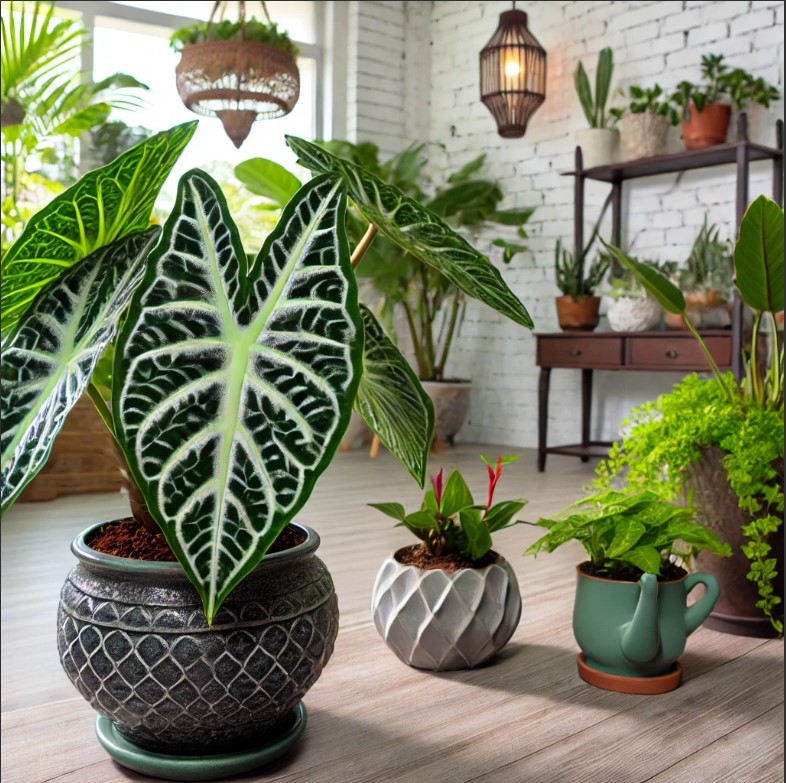
One of the most beautiful and certainly rarer indoor plants to find in your home—the Blue Alocasia. This spectacular variety is well known for its unusual and beautiful appearance, with dark blue-green leaves that reflect metallic colors in the light to create an otherworldy and magical aesthetic. While not exactly an everyday type of houseplant, it isn’t terribly difficult to care for with the right advice. This guide showcases the most important aspects of Blue Alocasia care and breaks down how to keep this beauty thriving in your home or garden!
The Blue Alocasia is sure to be a staple in your home from being a conversation starter amongst friends, or just a centerpiece in your plant collection whether you are experienced or new. We are here to bring you the care tips, optimal conditions in which this unique plant thrives, and main issues that you might encounter while trying to grow Hoia Carnosa.
1. What Is Blue Alocasia?
One of the Alocasia family, the blue Alocasia is sought after for its striking blue-tinged leaves. Renowned for its leaf reflecting metallic shine, this rare variety is a prized posee among plant aficionados.
2. Meanwhile, the Blue Alocasia looks and behaves like this:
Foliage: Blurish green blue (metallic)
Size: Can grow to 3 feet tall and has large, shiny leaves.
Type: Patterns in leaves shaped like an arrow, veins clearly defined.
Color: Dark blue and green reflective colors.
3. The Origin of Blue Alocasia
Native to Southeast Asia, the Blue Alocasia grows naturally in warm tropical climates but can also be grown indoors with a little bit of maintenance. This rare plant is on every deranged collector must-have list for their exotic appeal.
4. Blue Alocasia Ideal Conditions for Growing
Providing the right growing conditions is key for Blue Alocasia to thrive indoors:
Light: Bright indirect light.
Temperature: Warm conditions at 65–80º F (18-27 º C).
Humidity; High humidity, approximately 60% or more.
5. How to Water Blue Alocasia
After soil has dried out to the first inch
Should not pick up water
Water less in winter when the plant goes dormant.
6. How To Care For Alocasia Blue In a Pot Soil Requirements
Blue Alocasia likes soil that is well-draining:
A combination of peat, perlite, and orchid bark.
The soil should be mildly acidic, the pH level should be about 5.5 to 6.5
7. Fertilizing blue alocasia: What to Use
Ar Blue Alocasia care feed every 4-6 weeks during the growing season (spring and summer) using a balanced liquid fertilizer.
Do not fertilize in winter, the plant goes dormant and can be damage by fertilizing.
8. Repotting Blue Alocasia
Repot every 1–2 years, or once the plant outgrows its pot.
Find a pot [include for all types of plant repottings] just one size up from what its currently in, plants dont like to be moved into smaller pots so be sure to go bigger but not by much.
9. Pests and Diseases that Ail Blue Alocasia
Step 4: Protect the Blue Alocasia from Some Common Pests
Spider Mites: Treat with neem oil or insecticidal soap.
Aphids: Wash off with strong water spray or insecticidal soap
10. What to Do If Blue Alocasia Has Root Rot?
Use containers that allow proper drainage.
Water less when the temperature is cooler as the plant is not growing
11. Blue Alocasia and Humidity
Alocasia Blue grows under high humidity levels, making it easy to grow with glistening leaves.
Use a humidifier or mist the leaves to ensure necessary humidity.
12. Stressed Blue Alocasia Signs
Yellowing leaves: Overwatering or low humidity.
Brown tips: Indication that its either too dry, or not enough humidity in the room.
Leaves dropping: Can be caused by not watering enough and temperature stress.
13. Blue Alocasia Propagation
There are usually propagating methods for Blue Alocasia which used to be a division:
Divide the plant (with roots),
Plant the divisions in separate pots with new soil.
14. Blue Alocasia care keeping a Blue Alocasia looking good
To maintain the look of Blue Alocasia:
Dust the leaves often so that the plant can achieve optimal photosynthesis.
Remove the yellow or dead leaves for more growth
15. Where to Buy Blue Alocasia
Online: Try reputable sellers on Etsy, Amazon, and specialty plant shops.
Garden centre: Local nurseries should be your first stop for exotic plants.
Conclusion
The Blue Alocasia is an uncommon, gorgeous plant that makes for a beautiful focal point in every indoor garden. Still, its unique looks and eye catching leaves are most certainly worth a little bit of extra care compared to your standard houseplants. With proper care according to the guidelines in this article, Blue Alocasia will be around to brighten your home for many more years. This gorgeous plant would make a lovely and elegant addition to your collection whether you are an experienced plant collector or a novice.From seasoned collectors to young plant parents, this guide on how to care for your indoor Tiny Dancer will keep it going for you.






